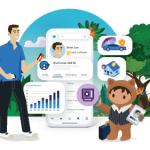Customers want hyper-personalised experiences. They expect businesses to anticipate their needs. They also want personalised micro moments across their preferred channels.
To achieve this, organisations need a single source of truth that pulls in data from multiple sources to create a 360-degree view of the customer. Together with Salesforce Customer 360, MuleSoft can help businesses achieve this vision.
The data integration challenge
Salesforce’s State of the Connected Customer report shows 80% of customers say the experience a business provides is as important as its products or services. For business buyers, that figure increases to 85%. Add that to the fact that 52% of customers expect personalised offers every time, and you’ll start to see how much data you need.
Providing hyper-personalised experiences depends on being able to access a single source of truth. Data comes from multiple sources. For a real-time 360-degree view of the customer, all that data needs to be integrated into your customer relationship management (CRM) system.
It’s a big ask. MuleSoft’s Connectivity Benchmark report shows the average enterprise-level organisation runs 843 individual applications . Yet, the surveyed respondents said only 29% of those applications on average are integrated.
Two major hurdles to data integration
Siloed data and legacy IT infrastructure remain the two major stumbling blocks to successful digital transformation.
Siloed sources of critical information undermine your operations by preventing a 360-degree view of the customer. Customers, too, are frustrated as they feel like they are dealing with separate departments, not one company. In fact, 65% of customers say they often have to repeat or re-explain information to different representatives.
MuleSoft’s research reveals that legacy IT infrastructure is an obstacle to many digital initiatives, with 34% of organisations reporting that it presents the main challenge to digital transformation.
While most organisations recognise the importance of data integration then, only 18% say they integrate end-user experiences across all channels.
How MuleSoft Composer delivers API integrations for Salesforce
MuleSoft Composer supercharges your CRM by bringing in data from other applications and making it available inside Salesforce Customer 360 — no coding involved. With its straightforward click and drag functionionality, MuleSoft Composer can defeat the challenges associated with siloed information.
Inefficiencies associated with disparate systems and manual processes cause slowdown for sales teams. Organisations could be taking orders in Google Sheets, using Netsuite for inventory, invoicing in Xero, and accepting payments via Paypal. But the data from each application is recorded separately, which makes it almost impossible to get a real-time picture of a purchase. This makes it difficult to provide efficient, personalised customer service.
MuleSoft Composer streamlines operations by integrating invoicing, orders, payments, and inventory applications. Once you have all that data in one place, it’s so much easier to get a 360-degree view of your customer.
Every team can benefit from MuleSoft Composer
It’s not just sales teams that benefit. By having all your data accessible, customer service teams can work faster to close tickets. Agents can access all the customer’s information straight away, instead of spending valuable time digging through different apps.
MuleSoft Composer can also connect with your Slack or Microsoft Teams apps. This allows you to set up triggers for other teams. For example, once the accounts team receives a payment, an alert can be sent to the fulfilment team to pack and send an order. By integrating your inventory apps, the team can act with confidence, knowing that they have real-time insight into stock availability.
The advantages go beyond your organisation. Set up automated notifications about their orders, and customers feel the benefits too. Your marketing teams can get in on the action as well. All your automated messages can carry personalised offers to encourage repeat purchases.
Customer expectations are changing
Customers are purchasing online more than ever before and expect quick turnarounds on orders and deliveries. The State of the Connected Customer report reveals that 58% of consumers expect to do more online shopping after the pandemic than before. Eighty percent of business buyers expect to conduct more business online.
Furthermore, 88% of customers expect companies to accelerate digital initiatives due to the COVID-19 pandemic. That makes the drive to create hyper-personalised experiences for customers even more compelling
Create integrations with clicks, not code
Because no coding is required to operate MuleSoft Composer, IT teams are free to focus on other tasks. Research shows that IT teams have to deliver 30% more projects on budgets that are growing by less than 10%. Everything you do to make digital transformation simpler is a step in the right direction.
Since MuleSoft Composer can integrate legacy applications into the Salesforce platform, an overhaul of an existing tech stack isn’t required. Instead, MuleSoft can work with the IT infrastructure the organisation already has in place.
Customer experience is a driving force behind business success. To deliver hyper-personalised customer experiences, you need a 360-degree view of your customer. To get that view, your data needs to be integrated into one system. MuleSoft Composer brings data into your Salesforce CRM simply and powerfully, providing your entire organisation with data they can rely on.
Tune in to the webinar to hear Amy McDonnell, Head of MuleSoft Composer, in conversation with Vijay Iyer, Director, Solution Engineering, at Salesforce. They discuss the challenges that are facing enterprise organisations and how Salesforce and MuleSoft Composer can help meet them.

























